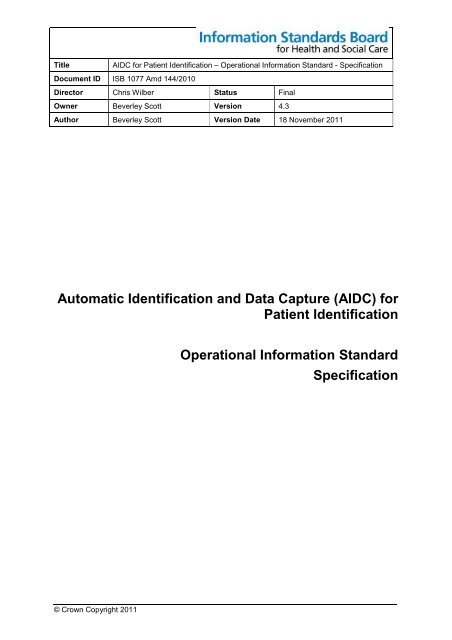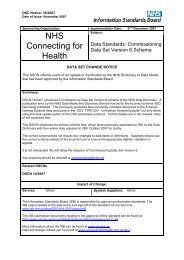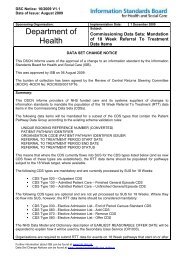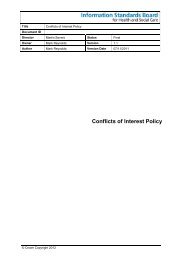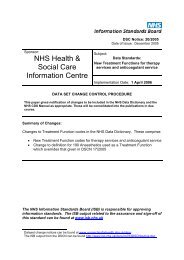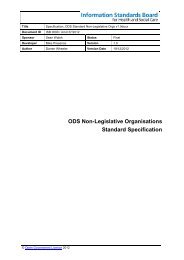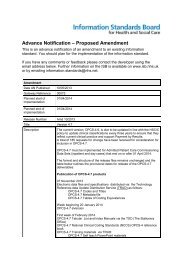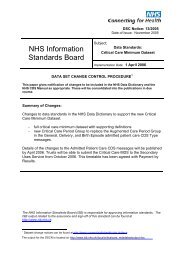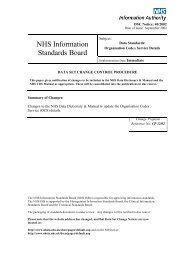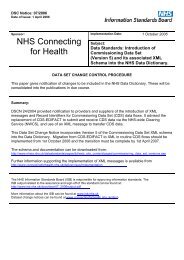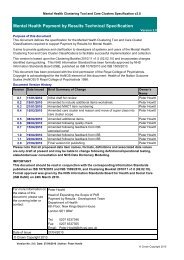Automatic Identification and Data Capture (AIDC) - Information ...
Automatic Identification and Data Capture (AIDC) - Information ...
Automatic Identification and Data Capture (AIDC) - Information ...
Create successful ePaper yourself
Turn your PDF publications into a flip-book with our unique Google optimized e-Paper software.
Title<strong>AIDC</strong> for Patient <strong>Identification</strong> – Operational <strong>Information</strong> St<strong>and</strong>ard - SpecificationDocument ID ISB 1077 Amd 144/2010Director Chris Wilber Status FinalOwner Beverley Scott Version 4.3Author Beverley Scott Version Date 18 November 2011<strong>Automatic</strong> <strong>Identification</strong> <strong>and</strong> <strong>Data</strong> <strong>Capture</strong> (<strong>AIDC</strong>) forPatient <strong>Identification</strong>Operational <strong>Information</strong> St<strong>and</strong>ardSpecification© Crown Copyright 2011
<strong>AIDC</strong> for Patient <strong>Identification</strong> – Operational <strong>Information</strong> St<strong>and</strong>ard - SpecificationISB 1077 Amd 144/2010 18-Nov-2011 Final v4.3Amendment History:Version Date Amendment History1.0 04-Aug-2011 Draft version submitted to ISB for appraisal1.1 10-Aug-2011 Inclusion of conformance criteria1.2 12-Aug-2011 Changes following NHS <strong>Data</strong> Dictionary review1.3 13-Aug-2011 Changes following ISB appraisal2.0 06-Sep-2011 Changes follow Change Proposal <strong>and</strong> ISB appraisal3.0 08-Sep-2011 Further changes following GS1 comments4.1 23-Sep-2011 Final changes following feedback from ISB4.2 08-Nov-2011 Changes following ISB Board4.3 18-Nov-2011 Formatting amendmentsForecast Changes:Anticipated ChangeWhenReviewers:This document must be reviewed by the following:Name Signature Title / Responsibility Date VersionNeil Lawrence <strong>AIDC</strong> Lead 08-Sep-2011 3.0Miles Gray Technical Architect 08-Sep-2011 3.0Stephen Pope <strong>AIDC</strong> Technical Architect 08-Sep-2011 3.0DHID - Clinical Safety Group / Clinical Safety Projects 08-Sep-2011 3.0Approvals:This document must be approved by the following:Name Signature Title / Responsibility Date Version<strong>Information</strong> St<strong>and</strong>ards Board for Health <strong>and</strong> Social Care (ISB) 08-Nov-2011 4.2Clinical Safety Group 08-Sep-2011 3.0Distribution:ISB distribution list.ISB website.Document Status:This is a controlled document.Whilst this document may be printed, the electronic version maintained on the ISB website(www.isb.nhs.uk) is the controlled copy. Any printed copies of the document are not controlled.© Crown Copyright 2011 Page 2 of 41
<strong>AIDC</strong> for Patient <strong>Identification</strong> – Operational <strong>Information</strong> St<strong>and</strong>ard - SpecificationISB 1077 Amd 144/2010 18-Nov-2011 Final v4.3Contents1 Overview ............................................................................................................. 41.1 Summary ....................................................................................................... 41.2 Guidance ....................................................................................................... 61.3 Related St<strong>and</strong>ards ......................................................................................... 62 Specification ........................................................................................................ 72.1 <strong>Information</strong> Specification ............................................................................... 72.2 Conformance Criteria .................................................................................. 103 Concept of Use .................................................................................................. 123.1 GS1 Global Service Relation Number (GSRN) ........................................... 123.2 Encoding the <strong>AIDC</strong> for Patient <strong>Identification</strong> <strong>Data</strong>set .................................. 124 <strong>AIDC</strong> for Patient <strong>Identification</strong> <strong>Data</strong>set .............................................................. 145 Patient Identity B<strong>and</strong>s – Example Encoded <strong>Data</strong> Strings .................................. 285.1 St<strong>and</strong>ard Identity B<strong>and</strong> – NHS Number Valid <strong>and</strong> Verified .......................... 285.2 St<strong>and</strong>ard Identity B<strong>and</strong> – NHS Number <strong>and</strong> Local Hospital Identifiers ........ 295.3 St<strong>and</strong>ard Identity B<strong>and</strong> – NHS Number Not Available / Invalid / Unverified 305.4 Baby Identity B<strong>and</strong> – Single Baby ............................................................... 315.5 Baby Identity B<strong>and</strong> – More Than One Baby ................................................ 326 Permitted <strong>Data</strong> Carriers ..................................................................................... 337 The Resulting Bar Coded Identity B<strong>and</strong> ............................................................ 348 Supporting <strong>Information</strong> ...................................................................................... 358.1 Contact <strong>Information</strong> ..................................................................................... 358.2 Useful resources ......................................................................................... 359 Known Risks <strong>and</strong> Issues ................................................................................... 369.1 Summary of Hazards ................................................................................... 369.2 Recommendations <strong>and</strong> Conclusions ........................................................... 3710 Glossary of Terms ............................................................................................. 39© Crown Copyright 2011 Page 3 of 41
<strong>AIDC</strong> for Patient <strong>Identification</strong> – Operational <strong>Information</strong> St<strong>and</strong>ard - SpecificationISB 1077 Amd 144/2010 18-Nov-2011 Final v4.31 Overview1.1 SummarySTANDARDSt<strong>and</strong>ardNumberTitleTypeDescriptionISB 1077<strong>Automatic</strong> <strong>Identification</strong> <strong>and</strong> <strong>Data</strong> <strong>Capture</strong> (<strong>AIDC</strong>) for Patient <strong>Identification</strong>.OperationalThis St<strong>and</strong>ard defines how to encode the NHS approved patient identifiersfor identity b<strong>and</strong>s into a two dimensional bar code, namely the GS1 <strong>Data</strong>Matrix Symbol. This st<strong>and</strong>ard covers production, verification <strong>and</strong> printingrules for the bar code. The st<strong>and</strong>ard uses the GS1 System of St<strong>and</strong>ards forcode numbering <strong>and</strong> bar coding <strong>and</strong> ISB 0099 - Patient Identifiers forIdentity B<strong>and</strong>s for the required data items. The resulting dataset is the <strong>AIDC</strong>for Patient <strong>Identification</strong> <strong>Data</strong>set.The purpose of this st<strong>and</strong>ard is to support the accurate, timely <strong>and</strong>,therefore, safer identification of NHS patients in Engl<strong>and</strong>. It is a technologyenabling st<strong>and</strong>ard. Implementation of this st<strong>and</strong>ard will enable subsequentprocesses involving the patient <strong>and</strong> care provided to the patient (wherethese processes are also bar coded) to be automatically identified using<strong>AIDC</strong> techniques, eg. bed management, phlebotomy, theatres management,medications administration. At this point, the full patient safety, cost <strong>and</strong>efficiency benefits of the st<strong>and</strong>ard will be realised.This st<strong>and</strong>ard should be reviewed <strong>and</strong> implemented alongside the existing<strong>AIDC</strong> Fundamental St<strong>and</strong>ard: ISB-0108: <strong>AIDC</strong> for the NHS in Engl<strong>and</strong> <strong>and</strong>related st<strong>and</strong>ards <strong>and</strong> guidance outlined in Sections 1.2 <strong>and</strong> 1.3.The following are out of scope for this Operational st<strong>and</strong>ard:• Identity b<strong>and</strong> design including display of human readable information.• Identity b<strong>and</strong> production, verification, fitting <strong>and</strong> use.• OBS for Newborn Screening Blood Spot Card Label.• The NHS required patient identifiers for identity b<strong>and</strong>s. These arem<strong>and</strong>ated by the NPSA st<strong>and</strong>ard ISB 0099.• Radio Frequency <strong>Identification</strong> (RFID).• Bar coding of blood <strong>and</strong> blood products tracking.• Bar coding of medical records tracking <strong>and</strong> document management.• Any of the business processes that adoption of this st<strong>and</strong>ard willenable, eg. scanning of bar codes <strong>and</strong> system design.© Crown Copyright 2011 Page 4 of 41
<strong>AIDC</strong> for Patient <strong>Identification</strong> – Operational <strong>Information</strong> St<strong>and</strong>ard - SpecificationISB 1077 Amd 144/2010 18-Nov-2011 Final v4.3Applies toThis st<strong>and</strong>ard applies to all health care settings in Engl<strong>and</strong> where an identityb<strong>and</strong> is worn by the patient. It also applies to all healthcare IT / systemsuppliers to the NHS in Engl<strong>and</strong> that develop <strong>and</strong> implement systems whichresult in the production of patient identity b<strong>and</strong>s.The users of the st<strong>and</strong>ard will be those involved in the design, manufacture,procurement, deployment <strong>and</strong> use of systems which result in the productionof patient identity b<strong>and</strong>s, as well as those who are associated with theprovision of care to the patient. These may include:• IT <strong>and</strong> informatics personnel.• Finance <strong>and</strong> procurement.• Departmental directors <strong>and</strong> managers.• Project managers.• Healthcare professionals.• Administration staff.• Estates.Although out of scope, due to the relationship between the two, the st<strong>and</strong>ardmay be used as additional supporting guidance when meeting therequirements of the UK Newborn Screening Programme. However, thisst<strong>and</strong>ard does not replace Output Based Specification (OBS) for theNewborn Screening Blood Spot Card Label.RELEASERelease Number Amd 144-2010TitleDescriptionStageProposedImplementationDateInitial St<strong>and</strong>ardThe first full specification of the st<strong>and</strong>ard.Full01/09/2013© Crown Copyright 2011 Page 5 of 41
<strong>AIDC</strong> for Patient <strong>Identification</strong> – Operational <strong>Information</strong> St<strong>and</strong>ard - SpecificationISB 1077 Amd 144/2010 18-Nov-2011 Final v4.31.2 GuidanceDocument ReferenceNPSA/2005/SPN011NPSA/2007/SPN024NPSA/2009/SPN002NameNPSA – Framework for Action – Right Patient Right Care.Identity b<strong>and</strong>s for hospital inpatients improve safety.St<strong>and</strong>ardising identity b<strong>and</strong>s improves safety.Risk to patient safety of not using the NHS Number as thenational identifier for all patients.NHS Numbers for Newborn Screening – OBS for the Blood SpotCard Label – v3.0 – Final – 8 February 20111.3 Related St<strong>and</strong>ardsReferenceISB 0108ISB 0099ISB 1503ISB 1504ISB 1506ISB 1501ISB 0149-01ISB 0149-02ISB 0129ISB 0160ISBT 128ISO/IEC15416:2002ISO/IEC15426-1:2006Title<strong>Automatic</strong> <strong>Identification</strong> <strong>and</strong> <strong>Data</strong> <strong>Capture</strong> (<strong>AIDC</strong>)Patient Identifiers for Identity B<strong>and</strong>sCommon User Interface – Date DisplayCommon User Interface – NHS Number Input <strong>and</strong> DisplayCommon User Interface – Patient Name Input <strong>and</strong> DisplayCommon User Interface – Time Display – Operational St<strong>and</strong>ardNHS Number for General PracticeNHS Number for Secondary CarePatient Safety Risk Management System - Manufacture of Health SoftwarePatient Safety Risk Management System - Deployment <strong>and</strong> Use of HealthSoftware<strong>Identification</strong>, labelling <strong>and</strong> information processing of human blood, tissue<strong>and</strong> organ products<strong>Automatic</strong> identification <strong>and</strong> data capture techniques. Bar code print qualitytest specification. Linear symbols<strong>Automatic</strong> identification <strong>and</strong> data capture techniques. Bar code verifierconformance specification. Linear symbols© Crown Copyright 2011 Page 6 of 41
<strong>AIDC</strong> for Patient <strong>Identification</strong> – Operational <strong>Information</strong> St<strong>and</strong>ard - SpecificationISB 1077 Amd 144/2010 18-Nov-2011 Final v4.32 Specification2.1 <strong>Information</strong> Specification# RequirementGeneral:1. When implementing the Operational st<strong>and</strong>ard, ISB 1077: <strong>AIDC</strong> for Patient<strong>Identification</strong>, the Fundamental st<strong>and</strong>ard ISB 0108: <strong>Automatic</strong> <strong>Identification</strong> <strong>and</strong> <strong>Data</strong><strong>Capture</strong> (<strong>AIDC</strong>) MUST be used as a reference guide.2. This st<strong>and</strong>ard SHOULD be implemented alongside the existing national st<strong>and</strong>ards,notices <strong>and</strong> guidance for patient identifiers <strong>and</strong> identity b<strong>and</strong>s, including CommonUser Interface (CUI) st<strong>and</strong>ards for the display of human readable information. Theseare all listed in Sections 1.2 <strong>and</strong> 1.3 of this document.3. When designing <strong>and</strong> manufacturing <strong>AIDC</strong> solutions / systems, including middleware,for purposes of Patient <strong>Identification</strong> in the NHS, ISB 0129: Application of Clinical RiskManagement relating to the Manufacture of Health Software (ISB 0129) SHOULD beused to identify <strong>and</strong> acceptably manage clinical safety risk associated with solution /system design.4. When procuring, deploying <strong>and</strong> using <strong>AIDC</strong> solutions / systems, including middleware,for purposes of Patient <strong>Identification</strong> in the NHS, ISB 0160: Application of Clinical RiskManagement relating to the Deployment <strong>and</strong> Use of Health Software (ISB 0160)SHOULD be used to identify <strong>and</strong> acceptably manage clinical safety risk associatedwith context of use <strong>and</strong> human factors. While not in scope for this st<strong>and</strong>ard, it isassumed that NHS organisations will address risks <strong>and</strong> issues related to identity b<strong>and</strong>production, verification, fitting <strong>and</strong> use as part of wider patient identification safety <strong>and</strong>information governance risk management for that NHS organisation. This st<strong>and</strong>ardMAY also be used as a framework for developing an <strong>AIDC</strong> for Patient <strong>Identification</strong>implementation project plan.5. All NHS identity b<strong>and</strong>s MUST carry the encoded <strong>AIDC</strong> for Patient <strong>Identification</strong><strong>Data</strong>set (found at Section 4) according to the instructions outlined in Section 3 -Concept of Operation. Examples can be found at Section 5.<strong>Data</strong> Carriers6. The data carrier which MUST be used to carry the <strong>AIDC</strong> for Patient <strong>Identification</strong><strong>Data</strong>set is the GS1 <strong>Data</strong> Matrix Symbol. (Refer to Section 6 – Permitted <strong>Data</strong>Carriers).7. It is recommended that, where space permits, all identity b<strong>and</strong>s SHOULD carry twoGS1 <strong>Data</strong> Matrix Symbols, containing exactly the same <strong>AIDC</strong> for Patient <strong>Identification</strong><strong>Data</strong>set, one at each end of the identity b<strong>and</strong>. This is for ease of scanning <strong>and</strong> as abackup, should one fail or become destroyed.© Crown Copyright 2011 Page 7 of 41
<strong>AIDC</strong> for Patient <strong>Identification</strong> – Operational <strong>Information</strong> St<strong>and</strong>ard - SpecificationISB 1077 Amd 144/2010 18-Nov-2011 Final v4.38. GS1 <strong>Data</strong> Matrix Symbol production, verification <strong>and</strong> printing MUST be conductedaccording to the technical instructions <strong>and</strong> guidance in GS1 document: “GS1 <strong>Data</strong>Matrix - An introduction <strong>and</strong> technical overview of the most advanced GS1 ApplicationIdentifiers compliant symbology”. (Available to GS1 registered members only. Referto ISB 0108 for guidance on registering an NHS organisation with GS1).9. For legacy purposes <strong>and</strong> to ease migration, NHS organisations MAY implement dualbar coding on identity b<strong>and</strong>s, i.e. a GS1 <strong>Data</strong> Matrix Symbol containing the <strong>AIDC</strong> forPatient <strong>Identification</strong> <strong>Data</strong>set AND a 1D / linear bar code containing the NHS Numberor local hospital / PAS number. The linear bar code MAY be a Code 39 or Code 128.It MUST NOT be a GS1 128 bar code as these are too wide to fit onto identity b<strong>and</strong>s.This st<strong>and</strong>ard assumes that identity b<strong>and</strong>s are not transferred between hospitals.10. Implementation of dual bar codes MUST NOT compromise the human readableinformation on the identity b<strong>and</strong>, nor the GS1 <strong>Data</strong> Matrix Symbol.Encoding the <strong>AIDC</strong> for Patient <strong>Identification</strong> <strong>Data</strong>set11. The <strong>AIDC</strong> for Patient <strong>Identification</strong> <strong>Data</strong>set (refer to Section 5) MUST be used exactlyas specified when encoding the data string for bar coded patient identity b<strong>and</strong>s. Thedataset will be published <strong>and</strong> maintained by the NHS <strong>Data</strong> Dictionary. M<strong>and</strong>atory,Required, <strong>and</strong> Optional data items are indicated for adult <strong>and</strong> baby identity b<strong>and</strong>s <strong>and</strong>MUST be adhered to.12. The GS1 <strong>Identification</strong> Key to be used for the encoding of patient identifiers on identityb<strong>and</strong>s MUST be the Global Service Relation Number (GSRN). Refer to Section 3 fora high level description <strong>and</strong> the GS1 General Specification (Section 4.7) for full details<strong>and</strong> allocation rules.13. There are up to 4 sections in a complete encoded data string for patient identification:The GSRN (containing the NHS Number); followed by up to 3 additional data strings:Hospital Identifiers; Patient Descriptive <strong>Data</strong>; <strong>and</strong> Baby Details. Each data stringMUST be identified by the appropriate GS1 Application Identifier.14. The GSRN data string MUST be identified by the Application Identifier „8018‟. TheGSRN is a required data string; It MUST be used in all cases.15. The data string Hospital Identifiers MUST be identified by Application Identifier „91‟.Hospital Identifiers is an optional data string; It MUST be used if the NHS Number isunavailable, invalid or unverified; It MAY be used if the NHS Number is available, valid<strong>and</strong> verified.16. The data string Patient Descriptive <strong>Data</strong> MUST be identified by Application Identifier„93‟. Patient Descriptive <strong>Data</strong> is a required data string; It MUST be used in all cases.17. The data string Baby Details MUST be identified by Application Identifier „92‟. BabyDetails is a REQUIRED data string; It MUST be used if the patient is a newborn baby /neonate.© Crown Copyright 2011 Page 8 of 41
<strong>AIDC</strong> for Patient <strong>Identification</strong> – Operational <strong>Information</strong> St<strong>and</strong>ard - SpecificationISB 1077 Amd 144/2010 18-Nov-2011 Final v4.318. GS1 Application Identifiers (AIs) 91 through to 99 are specifically allocated to“Company Internal <strong>Information</strong>”. (Refer to Section 3.10.2. of the GS1 GeneralSpecification). The NHS has allocated AIs 91, 92 <strong>and</strong> 93 for Hospital Identifiers, BabyDetails <strong>and</strong> Patient Descriptive <strong>Data</strong> respectively, for the specific purpose of encodingon patient identity b<strong>and</strong>s. They MUST NOT be used by the NHS to identify anythingelse.AIs 94 through to 97 inclusive have been reserved by the NHS for future allocation.AIs 98 <strong>and</strong> 99 have been put aside for local NHS organisation allocation <strong>and</strong> use.(See <strong>Information</strong> Specification No. 19).All allocation of AIs 91 through to 97 for the NHS will be subject to formal NHS <strong>Data</strong>Dictionary Change Requests <strong>and</strong> published in the NHS <strong>Data</strong> Dictionary.19. Additional optional data relating to the patient that is fixed MAY be added to the end ofthe encoded required dataset by local decision, eg. current gender, wristb<strong>and</strong> sizeindicator or alerts, etc. However, such optional data items are out of scope for thisst<strong>and</strong>ard. Neither are they m<strong>and</strong>ated or recommended by the NPSA as formal dataitems for the identity b<strong>and</strong>. As such, any decision to encode local optional data itemsfor use on the identity b<strong>and</strong> MUST be subject to a comprehensive clinical safety riskassessment for design <strong>and</strong> use in line with ISB 0160 <strong>and</strong> ISB 0129.Such optional data items MUST NOT include variable data about the patient such asthe hospital ward or department they are in, as this could lead to multiple identity b<strong>and</strong>production for the same patient.Optional data items MUST be identified by an appropriate GS1 Application Identifierfor “Company Internal <strong>Information</strong>”, ie. of either AI 98 or 99. Such optional data itemsMUST NOT be identified by any other GS1 Application Identifier.20. There MUST NOT be any patient related data encoded into the bar code on patientidentity b<strong>and</strong>s which is not printed on the identity b<strong>and</strong> in human readable form.21. The complete data string for the GS1 <strong>Data</strong> Matrix Symbol MUST NOT be printed inhuman readable form on the patient identity b<strong>and</strong>; It is too long <strong>and</strong> would cause enduser confusion. Printing of the patient related data contained within the GS1 <strong>Data</strong>Matrix Symbol MUST conform to ISB 0099© Crown Copyright 2011 Page 9 of 41
<strong>AIDC</strong> for Patient <strong>Identification</strong> – Operational <strong>Information</strong> St<strong>and</strong>ard - SpecificationISB 1077 Amd 144/2010 18-Nov-2011 Final v4.322. The GS1 Unique Organisation Prefix used in the GSRN number (data item 1.2) MUSTbe the fixed value of 5050898 to identify NHS Connecting for Health (as the serviceprovider of the NHS Number). It MUST NOT be the NHS Trust GS1 UniqueOrganisation Prefix (which is addressed by data item 1.8).23. IF the NHS Number is not known, the NHS Number portion (including the NHSNumber check digit) of the data string MUST be set to „9999999999‟ <strong>and</strong> the GSRNCheck Digit MUST be set to „3‟.24. The GSRN Check Digit MUST be calculated according to the instructions atAppendix 1.25. This St<strong>and</strong>ard Specification does not replace the Output Based Specification (OBS)for the Newborn Screening Blood Spot Card Label. However, it MAY be used asadditional supporting guidance in meeting the OBS requirements, due to therelationship between them. Systems which have been designed / configured toproduce both NN4B / baby identity b<strong>and</strong>s AND the Newborn Screening Blood SpotCard Label SHOULD be updated so that the GS1 <strong>Data</strong> Matrix Symbol containing the<strong>AIDC</strong> for Patient <strong>Identification</strong> <strong>Data</strong>set is printed on the identity b<strong>and</strong> <strong>and</strong> the GS1 128bar code containing the NHS Number is printed on the Blood Spot Card Label.26. NHS organisations SHOULD NOT procure <strong>AIDC</strong> technological solutions for encodingthe <strong>AIDC</strong> for Patient <strong>Identification</strong> <strong>Data</strong>set unless they can demonstrate compliancewith this st<strong>and</strong>ard.The key words MUST, SHOULD <strong>and</strong> MAY are defined in the information st<strong>and</strong>ardsdevelopment methodology. They follow RFC-2119.2.2 Conformance Criteria# Conformance Criteria1. With immediate effect, all new identity b<strong>and</strong> systems <strong>and</strong> solutions procured, deployed<strong>and</strong> used by the NHS can demonstrate compliance with the <strong>Automatic</strong> <strong>Identification</strong><strong>and</strong> <strong>Data</strong> <strong>Capture</strong> (<strong>AIDC</strong>) for Patient <strong>Identification</strong> Operational St<strong>and</strong>ard.2. From 1 April 2012, all NHS Trusts have established a clear migration plan to ensureexisting identity b<strong>and</strong> systems <strong>and</strong> solutions adhere to the <strong>AIDC</strong> for Patient<strong>Identification</strong> Operational St<strong>and</strong>ard by 1 October 2013.3. From 1 October 2013, all identity b<strong>and</strong>s produced in the NHS carry a GS1 <strong>Data</strong> MatrixSymbol containing at least the NHS Number, First Name, Last Name <strong>and</strong> Date ofBirth of the patient.© Crown Copyright 2011 Page 10 of 41
<strong>AIDC</strong> for Patient <strong>Identification</strong> – Operational <strong>Information</strong> St<strong>and</strong>ard - SpecificationISB 1077 Amd 144/2010 18-Nov-2011 Final v4.34. From 1 October 2013, all identity b<strong>and</strong>s produced in the NHS can clearly <strong>and</strong>unambiguously display the indicated <strong>AIDC</strong> for Patient <strong>Identification</strong> dataset in bothhuman readable <strong>and</strong> bar coded format.5. The GS1 <strong>Data</strong> Matrix Symbol can be accurately scanned in 100% of cases.6. A clinical safety risk assessment has been conducted by each NHS organisation priorto the implementation of this st<strong>and</strong>ard. The clinical safety assessment should be inline with the st<strong>and</strong>ard: ISB-0160: Patient Safety Risk Management for theDeployment <strong>and</strong> Use of Health Software.7. There are no clinical safety near misses or serious untoward incidents (SUIs) reportedas a direct result of the <strong>AIDC</strong> for Patient <strong>Identification</strong> st<strong>and</strong>ard.© Crown Copyright 2011 Page 11 of 41
<strong>AIDC</strong> for Patient <strong>Identification</strong> – Operational <strong>Information</strong> St<strong>and</strong>ard - SpecificationISB 1077 Amd 144/2010 18-Nov-2011 Final v4.33 Concept of Use3.1 GS1 Global Service Relation Number (GSRN)The Global Service Relation Number (GSRN) is the GS1 <strong>Identification</strong> Key that MUST beused when encoding the <strong>AIDC</strong> Patient <strong>Identification</strong> <strong>Data</strong>set. For full details of the GS1GSRN, refer to the GS1 General Specification (Section 4.7).A GSRN identifies a relationship between a service provider <strong>and</strong> a service recipient. Insimple terms, a company or business will issue a GSRN to a customer to identify theirrelationship. This could be a club membership, a member of a loyalty scheme or to identify apatient using NHS services.In the case of this st<strong>and</strong>ard, the service provider is NHS Connecting for Health (as theservice provider of the NHS Number) – identified by the GS1 Unique Organisation Prefix forNHS CFH; The service recipient is the individual patient receiving care <strong>and</strong> wearing anidentity b<strong>and</strong> – identified by their NHS Number.The GSRN is simply a key to a database which holds the information required, eg. PatientAdministration System (PAS). The GSRN can then be encoded in a bar code which is usedto access the database.3.2 Encoding the <strong>AIDC</strong> for Patient <strong>Identification</strong> <strong>Data</strong>setThe encoded <strong>AIDC</strong> for Patient <strong>Identification</strong> <strong>Data</strong>set results in a data string which consists ofthe following items (the full dataset can be found at Section 4):DATA STRING BEGINS:Application IdentifierGS1 Unique OrganisationPrefixApplication Identifier (AI) 8018 to indicate the followingdata string is a GS1 GSRN.A globally unique number assigned to a GS1 memberorganisation; In this case the GS1 member is NHSConnecting for Health, as the service provider of theNHS Number.Service Reference Number The number allocated to identify the service. In thiscase, the individual patient‟s NHS Number including thecheck digit.Check DigitA modulo 10 check digit – for the GSRN.1 Application Identifier Application Identifier (AI) 91 to indicate the following dataOrganisation Codestring is for Hospital Identifiers.The local NHS organisation code, allocated by the NHSOrganisation <strong>Data</strong> Service (ODS)..© Crown Copyright 2011 Page 12 of 41
GS1 Unique Org PrefixNHS NumberCheck DigitOrganisation CodePatient Hospital NumberGS Unique Organisation Prefix(NHS Trust)Last NameFirst NameDate of Birth(DD-Mmm-CCYY)Time of Birth(HH:mm)Number of Babies Indicator(e.g. 1/2)Baby of (Last Name)Baby Of (First Name)<strong>AIDC</strong> for Patient <strong>Identification</strong> – Operational <strong>Information</strong> St<strong>and</strong>ard - SpecificationISB 1077 Amd 144/2010 18-Nov-2011 Final v4.3Patient Hospital NumberGS1 Unique OrganisationPrefixApplication IdentifierLast NameFirst NameDate of BirthTime of BirthApplication IdentifierNumber of Babies IndicatorBaby of (Last Name)Baby of (First Name)DATA STRING ENDSThe local hospital / PAS number for the individualpatient.A globally unique number assigned to a GS1 memberorganisation; In this case the GS1 member is local NHSTrust / organisation.Application Identifier (AI) 93 to indicate the following datastring is for Patient Descriptive <strong>Data</strong>.The patient‟s last / surname.The patient‟s first / forename.The patient‟s date of birth.The patient‟s time of birth (if a baby).Application Identifier (AI) 92 to indicate the following datastring is for Baby Details.An identifier indicating number of babies born <strong>and</strong> theirrank.The baby‟s mother‟s last / surname.The baby‟s mother‟s first / forename.Format of the <strong>AIDC</strong> for Patient <strong>Identification</strong> <strong>Data</strong> StringAI GSRN AIHospitalIdentifiersAIPatient Descriptive <strong>Data</strong>AIBaby Details8018Fn7Fn10Fn1F91Fan3oran5Van10n7F93Fan35Van35Van11Fan5F92Fan3Fan35Van35V© Crown Copyright 2011 Page 13 of 41
<strong>AIDC</strong> for Patient <strong>Identification</strong> – Operational <strong>Information</strong> St<strong>and</strong>ard - SpecificationISB 1077 Amd 144/2010 18-Nov-2011 Final v4.34 <strong>AIDC</strong> for Patient <strong>Identification</strong> <strong>Data</strong>setThe following section lists the complete <strong>AIDC</strong> for Patient <strong>Identification</strong> <strong>Data</strong>set (v1.0 – 6 September 2011). This dataset will be published in<strong>and</strong> maintained by the NHS <strong>Data</strong> Dictionary.<strong>Data</strong>ItemNo<strong>Data</strong> Item <strong>Data</strong> Element /Attribute(NHS <strong>Data</strong>Dictionary)Description<strong>Data</strong>FormatFixed orVariablePermissibleValuesM=M<strong>and</strong>atoryR=RequiredO=OptionalSourceGS1AIComments1.1 ApplicationIdentifier(AI)N/AGS1 ApplicationIdentifier codewhich identifiesthe following dataelement string.n4 F 8018 =GlobalServiceRelationshipNumberM GS1 N/A Fixed value of8018. The GS1ApplicationIdentifier of 8018means the dataelement string isa GS1 GlobalServiceRelationshipNumber. AGSRN alwayshas 18 digits(numeric only).1.2 NHSConnectingfor HealthGS1 UniqueOrganisationPrefixN/ANHS Connectingfor Health (NHSCFH)n7 F 5050898 =NHSConnectingfor HealthM GS1 8018 The fixed value of5050898 MUSTbe used. It is theNHS CFH GS1Company Prefix.The localorganisation GS1Company PrefixMUST NOT beused. Forms thebeginning of theGS1 GSRN.© Crown Copyright 2011 Page 14 of 41
<strong>AIDC</strong> for Patient <strong>Identification</strong> – Operational <strong>Information</strong> St<strong>and</strong>ard - SpecificationISB 1077 Amd 144/2010 18-Nov-2011 Final v4.3<strong>Data</strong>ItemNo<strong>Data</strong> Item <strong>Data</strong> Element /Attribute(NHS <strong>Data</strong>Dictionary)Description<strong>Data</strong>FormatFixed orVariablePermissibleValuesM=M<strong>and</strong>atoryR=RequiredO=OptionalSourceGS1AIComments1.3 NHSNumberNHS NUMBERThe NHSNUMBER, theprimary identifierof a PERSON, isa unique identifierfora PATIENT withinthe NHS inEngl<strong>and</strong> <strong>and</strong>Wales.n10 F E.g.1234567890RNHS<strong>Data</strong>Dictionary8018 IF the NHSNumber ismissing, invalid orunverified, THENset the value to9999999999 ANDdata elements 1.5to 1.7 inclusivebecomeMANDATORY.Forms part of theGS1 GSRN.For humanreadable forms,the NHS NumberSHOULD bedisplayed inaccordance withthe NHSCommon UserInterfaceinformationst<strong>and</strong>ard "NHSNumber Input <strong>and</strong>Display", eg. the3,3,4 format. IFthe NHS Numberis not known,THEN the humanreadable formMUST be blank.© Crown Copyright 2011 Page 15 of 41
<strong>AIDC</strong> for Patient <strong>Identification</strong> – Operational <strong>Information</strong> St<strong>and</strong>ard - SpecificationISB 1077 Amd 144/2010 18-Nov-2011 Final v4.3<strong>Data</strong>ItemNo<strong>Data</strong> Item <strong>Data</strong> Element /Attribute(NHS <strong>Data</strong>Dictionary)1.4 GSRNCheck DigitDescriptionN/A A modulo 10check digit for theGSRN string<strong>Data</strong>FormatFixed orVariablePermissibleValuesM=M<strong>and</strong>atoryR=RequiredO=OptionalSourceGS1AICommentsn1 F E.g.: 1 M GS1 8018 <strong>Data</strong> elementdelimited as CSV.Ensures theGSRN is correct.Refer to Table Xfor check digitcalculation for the18-digit GSRN. Ifthe NHS Numberis not known orunverified, setthis value to 3.The final part ofthe GS1 GSRN.© Crown Copyright 2011 Page 16 of 41
<strong>AIDC</strong> for Patient <strong>Identification</strong> – Operational <strong>Information</strong> St<strong>and</strong>ard - SpecificationISB 1077 Amd 144/2010 18-Nov-2011 Final v4.3<strong>Data</strong>ItemNo<strong>Data</strong> Item <strong>Data</strong> Element /Attribute(NHS <strong>Data</strong>Dictionary)Description<strong>Data</strong>FormatFixed orVariablePermissibleValuesM=M<strong>and</strong>atoryR=RequiredO=OptionalSourceGS1AIComments1.5 ApplicationIdentifier(AI)N/AGS1 ApplicationIdentifier codewhich identifiesthe following dataelement string.N2 F 91 =HospitalIdentifiersM GS1 N/A <strong>Data</strong> elementdelimited as CSV.Fixed value of 91.The AI of 91identifies thecode number is aGS1 ApplicationIdentifier for“CompanyInternal<strong>Information</strong>”. TheNHS hasallocated the AI of91 to “HospitalIdentifiers”.<strong>Data</strong> elements1.5 to 1.7 areREQUIRED inthat they becomeMANDATORY inthe absence of avalid, verifiedNHS Number. IFthe NHS Numberis valid <strong>and</strong>verified, THENthe data elements1.5 to 1.7 areOPTIONAL.© Crown Copyright 2011 Page 17 of 41
260 CHAPTER 6 MOBILE TELEPHONY IN AFRICA: CROSS-COUNTRY COMPARISONthe Government in 1998, <strong>and</strong> to be implemented duringthe period 2000–2005 in order to foster investment<strong>and</strong> build ICT infrastructure. 21 It should be noted thatUg<strong>and</strong>a does not impose any limitations on foreign 22 1,040,127 mobile subscribers compared with about line telephone networks was associated with greatthe introduction of prepaid plans <strong>and</strong> the developmentof innovative products, such as packages tailored tothe low-income population, have had a positive impacton the spread of mobile telephony. Overall, the UCC terms of the freedom to make calls, <strong>and</strong> improvedconnectivity <strong>and</strong> mobility. Mobiles telephones are most people’s homes. In particular, mobiles have been the use of mobile technology in improving knowledge Ug<strong>and</strong>a.Mobile market developmentWith new market entrants <strong>and</strong> licences issued forthe Ug<strong>and</strong>an mobile market, mobile prices <strong>and</strong> providers, in addition to the privatized incumbent, hasled to increasingly affordable prices <strong>and</strong> better qualityof service. While national GDP has had an averagegrowth rate of 5 per cent since 2000, the mobile 25 per cent per year since 1998, when MTN startedto operate in the country. Despite the rapid growthin mobile telephony, the majority of the populationstill does not have access to basic telephony as theinfrastructures are still inadequate <strong>and</strong> tariffs are still too<strong>and</strong> over 39 per cent of the population living below of, <strong>and</strong> a commentary on, rural coverage by the mainproviders.On the other h<strong>and</strong>, international tariffs have on thewhole been reduced. In December 2003, international D. Cross-country comparisonThe rapid spread of mobile telephony in low incometo a much higher percentage growth in the number ofmobile subscribers than in wealthier countries such percentage of mobile subscribers grew by 494.25 percent in Nigeria, 172.93 per cent in Ug<strong>and</strong>a, 107.37 perThe cost of mobile telephone calls has changed inrecent years <strong>and</strong> in particular from 2002 onwards.Although Nigeria <strong>and</strong> Ug<strong>and</strong>a show the same trend, astariffs for both peak <strong>and</strong> off-peak calls have decreasedsince 2002, for Nigeria the fall has been more dramatic.shows a decrease in costs for off-peak calls <strong>and</strong> a much Rates for the adoption of mobile telephones <strong>and</strong>mobile teledensity differ vastly from country tocountry. Chart 6.14 describes the effect of the entry ofa second mobile operator in the market on the numberof subcribers. Table 6.4 provides data on the changesin mobile teledensity during the period 2002 – 2006. have a density of between 5 <strong>and</strong> 10, <strong>and</strong> Ug<strong>and</strong>a lessthan 5. Moreover, divergences within the same countryare equally as large, a fact which suggests that currentpolicies are effective in promoting ICT access in urbanareas, while there is still a policy gap as regards rural a density of as 25, while in most of the rural onesteledensities are as low as 0.1. The overall telephonecoverage is less than 45 per cent of Nigeria’s total different. While national teledensity is quite high at46, rural areas have values of 5. On the whole, mobilepenetration in rural areas of the countries underINFORMATION ECONOMY REPORT 2007-2008
<strong>AIDC</strong> for Patient <strong>Identification</strong> – Operational <strong>Information</strong> St<strong>and</strong>ard - SpecificationISB 1077 Amd 144/2010 18-Nov-2011 Final v4.3<strong>Data</strong>ItemNo<strong>Data</strong> Item2.1 ApplicationIdentifier(AI)<strong>Data</strong>Element /Attribute(NHS <strong>Data</strong>Dictionary)N/ADescriptionGS1 ApplicationIdentifier codewhich identifiesthe followingdata elementstring.<strong>Data</strong>FormatFixed orVariablePermissibleValuesN2 F 93 = PatientDescriptive<strong>Data</strong>M=M<strong>and</strong>atoryR=RequiredO=OptionalSourceGS1AICommentsM GS1 N/A Fixed value of 93. AI of93 identifies the codenumber is a GS1Application Identifier for“Company Internal<strong>Information</strong>”. The NHShas allocated the AI of 93to “Patient Descriptive<strong>Data</strong>”.<strong>Data</strong> elements 2.1 to 2.4are MANDATORY for ALLpatient wrist / identityb<strong>and</strong>s.<strong>Data</strong> element 2.5 isREQUIRED in that itbecomes MANDATORYfor neonates <strong>and</strong> newbornbaby wrist / identityb<strong>and</strong>s.© Crown Copyright 2011 Page 20 of 41
<strong>AIDC</strong> for Patient <strong>Identification</strong> – Operational <strong>Information</strong> St<strong>and</strong>ard - SpecificationISB 1077 Amd 144/2010 18-Nov-2011 Final v4.3<strong>Data</strong>ItemNo<strong>Data</strong> Item<strong>Data</strong>Element /Attribute(NHS <strong>Data</strong>Dictionary)2.2 Last Name PERSONFAMILYNAMEDescriptionThat part of aPERSON'sname which isused to describefamily, clan,tribal group, ormaritalassociation.<strong>Data</strong>FormatFixed orVariablePermissibleValuesM=M<strong>and</strong>atoryR=RequiredO=OptionalSourcean35 V E.g. SMITH R NHS<strong>Data</strong>Dictionary<strong>and</strong> NHSCommonUserInterfaceGS1AIComments93 <strong>Data</strong> element delimited asCSV.For human readableforms, the Last NameSHOULD be displayed inaccordance with the NHSCommon User Interfaceinformation st<strong>and</strong>ard"Patient Name Input <strong>and</strong>Display", eg. the LastName MUST be displayedin capitals.2.3 First Name PERSONGIVENNAMEThe forename orgiven name of aPERSON.an35 V E.g. David R NHS<strong>Data</strong>Dictionary<strong>and</strong> NHSCommonUserInterface93 <strong>Data</strong> element delimited asCSV.For human readableforms, the First NameSHOULD be displayed inaccordance with the NHSCommon User Interfaceinformation st<strong>and</strong>ard"Patient Name Input <strong>and</strong>Display", eg. the FirstName MUST follow theLast Name <strong>and</strong> bedisplayed using initialcapitals.© Crown Copyright 2011 Page 21 of 41
<strong>AIDC</strong> for Patient <strong>Identification</strong> – Operational <strong>Information</strong> St<strong>and</strong>ard - SpecificationISB 1077 Amd 144/2010 18-Nov-2011 Final v4.3<strong>Data</strong>ItemNo<strong>Data</strong>Item<strong>Data</strong> Element /Attribute(NHS <strong>Data</strong>Dictionary)Description<strong>Data</strong>FormatFixed orVariablePermissibleValuesM=M<strong>and</strong>atoryR=RequiredO=OptionalSourceGS1AIComments2.4 Date ofBirthDATE OF BIRTH(PATIENTIDENTIFICATION)The date ofbirth of thepatient.an11DD-Mm-CCYYFE.g. 21-Nov-1993RNHS<strong>Data</strong>Dictionary- NewItem <strong>and</strong>NHSCommonUserInterface93 <strong>Data</strong> elementdelimited as CSV.For human readableforms, the date formatSHOULD be displayedin accordance with theNHS Common UserInterface informationst<strong>and</strong>ard "DateDisplay".For neonates <strong>and</strong>newborn babies, thedata element 3.6 'Timeof Birth' MUST beencoded after (<strong>and</strong>printed next to) dataelement 2.4 'Date ofBirth'.© Crown Copyright 2011 Page 22 of 41
<strong>AIDC</strong> for Patient <strong>Identification</strong> – Operational <strong>Information</strong> St<strong>and</strong>ard - SpecificationISB 1077 Amd 144/2010 18-Nov-2011 Final v4.3<strong>Data</strong>ItemNo<strong>Data</strong>Item<strong>Data</strong> Element /Attribute(NHS <strong>Data</strong>Dictionary)Description<strong>Data</strong>FormatFixed orVariablePermissibleValuesM=M<strong>and</strong>atoryR=RequiredO=OptionalSourceGS1AIComments2.5 Time ofBirthTIME OF BIRTH(PATIENTIDENTIFICATION)The time ofbirth of theneonate /newborn baby.an5HH:mmF E.g. 15:30 R NHS<strong>Data</strong>Dictionary- NewItem <strong>and</strong>NHSCommonUserInterface92 <strong>Data</strong> elementdelimited as CSV.For human readableforms, the time formatMUST be displayed inaccordance with theNHS Common UserInterface informationst<strong>and</strong>ard "TimeDisplay", e.g. displaytime using 24 hourclock <strong>and</strong> separate thehours <strong>and</strong> minuteswith a colon.This data element isREQUIRED in that itbecomesMANDATORY forneonates <strong>and</strong>newborn babies. Itshould be printedimmediately to theright of the dataelement 2.4 'Date ofBirth'.© Crown Copyright 2011 Page 23 of 41
<strong>AIDC</strong> for Patient <strong>Identification</strong> – Operational <strong>Information</strong> St<strong>and</strong>ard - SpecificationISB 1077 Amd 144/2010 18-Nov-2011 Final v4.3<strong>Data</strong>ItemNo<strong>Data</strong> Item3.1 ApplicationIdentifier(AI)<strong>Data</strong>Element /Attribute(NHS <strong>Data</strong>Dictionary)N/ADescriptionGS1ApplicationIdentifiercode whichidentifiesthefollowingdataelementstring.<strong>Data</strong>FormatFixed orVariablePermissibleValuesn2 F 92 = BabyDetailsM=M<strong>and</strong>atoryR=RequiredO=OptionalSourceGS1AICommentsR GS1 N/A Fixed value of 92. AI of 92identifies the code number isa GS1 Application Identifierfor “Company Internal<strong>Information</strong>”. The NHS hasallocated the AI of 92 to“Baby Details”.<strong>Data</strong> elements 3.2 to 3.3 areREQUIRED in that theybecome MANDATORY fornewborn babies / neonates inthe absence of a valid <strong>and</strong>verified NHS Number. <strong>Data</strong>element 3.4 is OPTIONAL. IFthe NHS Number is valid <strong>and</strong>verified, THEN data elements3.2 to 3.4 are OPTIONAL buthighly recommended.© Crown Copyright 2011 Page 24 of 41
<strong>AIDC</strong> for Patient <strong>Identification</strong> – Operational <strong>Information</strong> St<strong>and</strong>ard - SpecificationISB 1077 Amd 144/2010 18-Nov-2011 Final v4.3<strong>Data</strong>ItemNo<strong>Data</strong>Item<strong>Data</strong> Element /Attribute(NHS <strong>Data</strong>Dictionary)Description<strong>Data</strong>FormatFixed orVariablePermissibleValuesM=M<strong>and</strong>atoryR=RequiredO=OptionalSourceGS1AIComments3.2 NumberofBabiesIndicatorNUMBER OFBABIESINDICATOR(PATIENTIDENTIFICATION)An identifierindicatingnumber ofbabies born<strong>and</strong> their rank.an3n/nFEg:1/1 = onebaby;1/2 = First oftwo babies(twin 1);2/2 =Second oftwo babies(twin 2); <strong>and</strong>so on.RNHS <strong>Data</strong>Dictionary- New<strong>Data</strong> Item92 <strong>Data</strong> element delimitedby CSV.For human readableforms, the label "Rank"MUST be displayed tothe left of the Numberof Babies Indicator.This data item isREQUIRED(SeeAppendix 2for the fullspecificationof this dataitem.© Crown Copyright 2011 Page 25 of 41
<strong>AIDC</strong> for Patient <strong>Identification</strong> – Operational <strong>Information</strong> St<strong>and</strong>ard - SpecificationISB 1077 Amd 144/2010 18-Nov-2011 Final v4.3<strong>Data</strong>ItemNo<strong>Data</strong>Item3.3 Baby Of(LastName)<strong>Data</strong>Element /Attribute(NHS <strong>Data</strong>Dictionary)PERSONFAMILYNAME(MOTHEROF BABY)DescriptionThat part of aPERSON'sname which isused todescribe family,clan, tribalgroup, or maritalassociation,where thePERSON hereis the mother ofthe baby.<strong>Data</strong>FormatFixed orVariablePermissibleValuesM=M<strong>and</strong>atoryR=RequiredO=OptionalSourcean35 V E.g. SMITH R NHS <strong>Data</strong>Dictionary- New Item<strong>and</strong> NHSCommonUserInterfaceGS1AIComments93 <strong>Data</strong> element delimitedas CSV.For human readableforms, the label "BabyOf" MUST be displayedfirst, followed by themother's FAMILY NAME(in capitals). This MAYbe followed by themother's GIVEN NAME(in initial capitals).Person names SHOULDbe displayed inaccordance with theCommon User Interfaceinformation st<strong>and</strong>ard"Patient Name Input <strong>and</strong>Display).This data item isREQUIRED© Crown Copyright 2011 Page 26 of 41
<strong>AIDC</strong> for Patient <strong>Identification</strong> – Operational <strong>Information</strong> St<strong>and</strong>ard - SpecificationISB 1077 Amd 144/2010 18-Nov-2011 Final v4.3<strong>Data</strong>ItemNo<strong>Data</strong>Item3.4 Baby Of(FirstName)<strong>Data</strong>Element /Attribute(NHS <strong>Data</strong>Dictionary)PERSONGIVENNAME(MOTHEROF BABY)DescriptionThe forenameor given nameof a PERSON,where thePERSON hereis the mother ofthe baby.<strong>Data</strong>FormatFixed orVariablePermissibleValuesM=M<strong>and</strong>atoryR=RequiredO=OptionalSourcean35 V E.g. S<strong>and</strong>ra O NHS <strong>Data</strong>Dictionary- New Item<strong>and</strong> NHSCommonUserInterfaceGS1AIComments93 <strong>Data</strong> element delimitedas CSV.For human readableforms, the label "BabyOf" MUST be displayedfirst, followed by themother's FAMILY NAME(in capitals). This MAYbe followed by themother's GIVEN NAME(in initial capitals).Person names MUST bedisplayed in accordancewith the Common UserInterface informationst<strong>and</strong>ard "Patient NameInput <strong>and</strong> Display).This data item isOPTIONAL.© Crown Copyright 2011 Page 27 of 41
<strong>AIDC</strong> for Patient <strong>Identification</strong> – Operational <strong>Information</strong> St<strong>and</strong>ard - SpecificationISB 1077 Amd 144/2010 18-Nov-2011 Final v4.35 Patient Identity B<strong>and</strong>s – Example Encoded <strong>Data</strong> StringsUsing the information provided in Sections 3 <strong>and</strong> 4, the encoded data string for identity b<strong>and</strong>s can be represented in the following humanreadable way: (NB: Brackets are there to aid the human readable format <strong>and</strong> MUST be removed for machine readable codes):5.1 St<strong>and</strong>ard Identity B<strong>and</strong> – NHS Number Valid <strong>and</strong> VerifiedThe patient is a female with a valid <strong>and</strong> verified NHS Number. The Trust does not require local information to be encoded <strong>and</strong> has notregistered with GS1 for their GS1 Unique Organisation Prefix.(8018)505089897758581513(93)NDIAYE,Elom,02-Feb-1950,Date of BirthFirst NameLast NameApplication Identifier (Patient Descriptive <strong>Data</strong>)GSRN Check DigitNHS Number including Check DigitGS1 Unique Organisation Prefix for NHS Connecting for Health (CFH)Application Identifier (GSRN)© Crown Copyright 2011 Page 28 of 41
<strong>AIDC</strong> for Patient <strong>Identification</strong> – Operational <strong>Information</strong> St<strong>and</strong>ard - SpecificationISB 1077 Amd 144/2010 18-Nov-2011 Final v4.35.2 St<strong>and</strong>ard Identity B<strong>and</strong> – NHS Number <strong>and</strong> Local Hospital IdentifiersThe patient is an infant male with a valid NHS Number available. The Trust wishes to include local hospital information extracted directlyfrom the PAS <strong>and</strong> the Trust‟s GS1 Unique Organisation Prefix (which is optional).(8018)505089899900054513(91)RAN,567823,50897671,(93)PRITCHARD,Thomas,28-Apr-2005,Date of BirthFirst NameLast NameApplication Identifier (Patient Descriptive <strong>Data</strong>)GS1 Unique Organisation Prefix for the NHS TrustPatient Hospital NumberOrganisation CodeApplication Identifier (Hospital Identifiers)GSRN Check DigitNHS Number including Check DigitGS1 Unique Organisation Prefix for NHS Connecting for Health (CFH)Application Identifier (GSRN)© Crown Copyright 2011 Page 29 of 41
<strong>AIDC</strong> for Patient <strong>Identification</strong> – Operational <strong>Information</strong> St<strong>and</strong>ard - SpecificationISB 1077 Amd 144/2010 18-Nov-2011 Final v4.35.3 St<strong>and</strong>ard Identity B<strong>and</strong> – NHS Number Not Available / Invalid / UnverifiedThe patient is an adult female – NHS Number not available (or invalid or unverified). Therefore, the NHS Trust has used local hospitalinformation extracted directly from the PAS. The Trust has not registered with GS1 yet to obtain their own GS1 Unique Organisation Prefix.(8018)505089899999999993(91)AD12,ABC123XZ,(93)O‟DONNELL,Sarah,30-Oct-1974,Date of BirthFirst NameLast NameApplication Identifier (Patient Descriptive <strong>Data</strong>)Patient Hospital NumberOrganisation CodeApplication Identifier (Hospital Identifiers)GSRN Check DigitNHS Number including Check DigitGS1 Unique Organisation Prefix for NHS Connecting for Health (CFH)Application Identifier (GSRN)© Crown Copyright 2011 Page 30 of 41
<strong>AIDC</strong> for Patient <strong>Identification</strong> – Operational <strong>Information</strong> St<strong>and</strong>ard - SpecificationISB 1077 Amd 144/2010 18-Nov-2011 Final v4.35.4 Baby Identity B<strong>and</strong> – Single BabyThe patient is a one day old female single baby <strong>and</strong> has been registered with NN4B <strong>and</strong> therefore has a valid <strong>and</strong> verified NHS Number.The Trust wishes to include local hospital information extracted directly from the PAS <strong>and</strong> the Trust‟s GS1 Unique Organisation Prefix.(8018)505089812345678908(91)BRI,987654A,50234510,(93)CHAPPELL,Emma,03-Aug-2011,07:33,(92)1/1,CHAPPELL,Ann,GSRN Check DigitNHS Number including Check DigitGS1 Unique Organisation Prefix for NHS Connecting for Health (CFH)Application Identifier (GSRN)GS1 Unique Organisation Prefix for the NHS TrustPatient Hospital NumberOrganisation CodeLast NameApplication Identifier (Hospital Identifiers)First NameTime of BirthDate of BirthApplication Identifier (Patient Descriptive <strong>Data</strong>)AI (Baby Details)Baby of(First Name)Baby of (Last Name)Number of Babies Indicator© Crown Copyright 2011 Page 31 of 41
<strong>AIDC</strong> for Patient <strong>Identification</strong> – Operational <strong>Information</strong> St<strong>and</strong>ard - SpecificationISB 1077 Amd 144/2010 18-Nov-2011 Final v4.35.5 Baby Identity B<strong>and</strong> – More Than One BabyThe patient is the one day old second baby of male triplets <strong>and</strong> has been registered with NN4B <strong>and</strong> therefore has a valid <strong>and</strong> verified NHSNumber. The Trust wishes to include local hospital information extracted directly from the PAS <strong>and</strong> the Trust‟s GS1 Unique Organisation Prefix.(8018)505089845055771041(91)R1A03,DM62438,50234510,(93)CHEUNG,Tao,03-Aug-2011,07:33,(92)2/3,CHEUNG,ChanGSRN Check DigitNHS Number including Check DigitGS1 Unique Organisation Prefix for NHS Connecting for Health (CFH)Application Identifier (GSRN)Patient Hospital NumberOrganisation CodeLast NameApplication Identifier (Hospital Identifiers)First NameTime of BirthDate of BirthAI (Baby Details)Application Identifier (Patient Descriptive <strong>Data</strong>)GS1 Unique Organisation Prefix for the NHS TrustBaby of(First Name)Baby of (Last Name)Number of Babies Indicator© Crown Copyright 2011 Page 32 of 41
<strong>AIDC</strong> for Patient <strong>Identification</strong> – Operational <strong>Information</strong> St<strong>and</strong>ard - SpecificationISB 1077 Amd 144/2010 18-Nov-2011 Final v4.36 Permitted <strong>Data</strong> CarriersThe following data carriers are permitted for use with the <strong>AIDC</strong> for Patient <strong>Identification</strong>st<strong>and</strong>ard.GS1 <strong>Data</strong> Matrix SymbolExampleRecommendationCommentsProsConsGS1 <strong>Data</strong>MatrixSymbolProduction,Verification <strong>and</strong>Printing TechnicalInstructionsMUST• This st<strong>and</strong>ard m<strong>and</strong>ates the use of the GS1 <strong>Data</strong> Matrix Symbolcontaining the <strong>AIDC</strong> for Patient <strong>Identification</strong> <strong>Data</strong>set.• For legacy purposes <strong>and</strong> to ease migration, NHS organisationsMAY implement dual bar coding on identity b<strong>and</strong>s, ie. a GS1 <strong>Data</strong>Matrix Symbol containing the <strong>AIDC</strong> for Patient <strong>Identification</strong><strong>Data</strong>set AND a 1D / linear bar code containing the NHS Numberor local hospital / PAS number. The linear bar code MAY be aCode 39 or Code 128. It SHOULD NOT be a GS1 128 bar codeas these are too wide to fit onto identity b<strong>and</strong>s.• Carries alpha numeric data.• Capable of encoding much larger amount of data than linear barcodes.• Fit into small spaces / onto small items, thereby improvingscanning ease <strong>and</strong> accuracy <strong>and</strong> ideal for patient identity b<strong>and</strong>s.• The GS1 <strong>Data</strong> Matrix Symbol is an emerging symbology that willbe indicated for use in other <strong>AIDC</strong> st<strong>and</strong>ards, e.g. Sterile surgicalinstruments tracking.• It is likely that a number of existing systems in the NHS will beunable to create the GS1 <strong>Data</strong> Matrix bar code format withoutmaking system changes.• Some existing older model printers in the NHS will not be capableof printing the GS1 <strong>Data</strong> Matrix Symbol.• “GS1 <strong>Data</strong>Matrix: An introduction <strong>and</strong> technical overview of themost advanced GS1 Application Identifiers compliant symbology”.© Crown Copyright 2011 Page 33 of 41
<strong>AIDC</strong> for Patient <strong>Identification</strong> – Operational <strong>Information</strong> St<strong>and</strong>ard - SpecificationISB 1077 Amd 144/2010 18-Nov-2011 Final v4.37 The Resulting Bar Coded Identity B<strong>and</strong>Examples of compliant identity b<strong>and</strong>s are as Figures 1, 2 <strong>and</strong> 3 below. Note that allexamples are dual bar coded, i.e. Inclusion of the GS1 <strong>Data</strong> Matrix Symbol (in some casestwice) AND an existing proprietary bar code (e.g. Code 39 or Code 128 bar code) containingthe NHS Number of local hospital / PAS number.Figure 1:Figure 2:Figure 3:© Crown Copyright 2011 Page 34 of 41
<strong>AIDC</strong> for Patient <strong>Identification</strong> – Operational <strong>Information</strong> St<strong>and</strong>ard - SpecificationISB 1077 Amd 144/2010 18-Nov-2011 Final v4.38 Supporting <strong>Information</strong>8.1 Contact <strong>Information</strong>For further information about the <strong>AIDC</strong> information st<strong>and</strong>ards for the NHS in Engl<strong>and</strong>, pleasecontact the following:SponsorNameOrganisationEmail AddressPeter Coates, Commercial DirectorDepartment of HealthPeter.Coates@dh.gsi.gov.ukDeveloperNameOrganisationEmail AddressNeil LawrenceDepartment of Health Informatics Directorateneil.lawrence@nhs.net<strong>AIDC</strong> Programme Lead <strong>and</strong> Maintenance ManagerNameOrganisationEmail AddressNeil LawrenceDepartment of Health Informatics Directorateneil.lawrence@nhs.net8.2 Useful resourceshttp://www.connectingforhealth.nhs.uk/systems<strong>and</strong>services/aidcwww.isb.nhs.uk/use/baselines/aidcwww.gs1uk.org© Crown Copyright 2011 Page 35 of 41
<strong>AIDC</strong> for Patient <strong>Identification</strong> – Operational <strong>Information</strong> St<strong>and</strong>ard - SpecificationISB 1077 Amd 144/2010 18-Nov-2011 Final v4.39 Known Risks <strong>and</strong> IssuesPlease refer to the document, “<strong>AIDC</strong> for Patient <strong>Identification</strong> – Clinical Safety Case <strong>and</strong>Closure Report – v1.1 – 8 Sep 2011” (which contains the Hazard Log)” for full details of allrisks <strong>and</strong> issues related to this st<strong>and</strong>ard. However, a brief summary of the hazards <strong>and</strong>recommendations are provided below:9.1 Summary of HazardsSix key hazards were identified during the end to end hazard assessment process, resultingin a total of ten risks. Hazards <strong>and</strong> causes were identified from a range of factors, includingtechnical issues, clinical process, usability <strong>and</strong> data quality. They were all considered inscope for <strong>AIDC</strong> for Patient <strong>Identification</strong>, as the consequences arising from the hazards wereassessed to be patient safety related. Mitigations for the hazards are primarily theproduction of compliant identity b<strong>and</strong>s, examples of which are provided earlier in Section 7.See below for the high level summary of the key hazards:HazardID<strong>AIDC</strong>PI/H001Hazard NameBar code doesnot fit on theidentity b<strong>and</strong>.Hazard Description<strong>Data</strong> is encoded in the GS1 <strong>Data</strong> Matrix Symbol, but notprinted in human readable form on the identity b<strong>and</strong>.<strong>AIDC</strong>PI/H002Lack of 2D barcode on theidentity b<strong>and</strong>.NHS Trust's existing <strong>AIDC</strong> systems <strong>and</strong> processes aredependent upon their proprietary bar code, eg. Code 39 orCode 128 or a GS1 128 linear bar code containing the NHSNumber or local hospital / PAS number.<strong>AIDC</strong>PI/H003Patientinformationunavailable orhidden.Inability to identity the patient by scanning of the bar code.On a baby identity b<strong>and</strong>, it is not clear which is the name ofthe baby (the patient) <strong>and</strong> which is the name of the mother ofthe baby.<strong>Data</strong> is encoded in the GS1 <strong>Data</strong> Matrix Symbol, but notprinted in human readable form on the identity b<strong>and</strong>.© Crown Copyright 2011 Page 36 of 41
<strong>AIDC</strong> for Patient <strong>Identification</strong> – Operational <strong>Information</strong> St<strong>and</strong>ard - SpecificationISB 1077 Amd 144/2010 18-Nov-2011 Final v4.3<strong>AIDC</strong>PI/H004Systemincompatibility.NHS Trust's existing <strong>AIDC</strong> systems <strong>and</strong> processes aredependent upon their proprietary bar code, e.g. Code 39 orCode 128 or a GS1 128 linear bar code containing the NHSNumber or local hospital / PAS number.<strong>AIDC</strong>PI/H005Usermisinterpretationof dataOn a baby identity b<strong>and</strong>, it is not clear which is the name ofthe baby (the patient) <strong>and</strong> which is the name of the mother ofthe baby.GS1 code numbers that make up the encoded data string,such Application Identifiers <strong>and</strong> the GSRN check digit areprinted in human readable form on the identity b<strong>and</strong>.<strong>Information</strong> on the identity b<strong>and</strong> is ambiguous or unclear, e.g.display of names, date of birth, NHS Number <strong>and</strong> time ofbirth.<strong>AIDC</strong>PI/H006Misidentificationof bar codedartefact.Use of the <strong>AIDC</strong> for Patient <strong>Identification</strong> bar code on otherdocumentary artefacts other than the identity b<strong>and</strong>, leading tomisidentification of the artefact.9.2 Recommendations <strong>and</strong> Conclusionsa. GS1 128 linear bar codes MUST NOT be used on identity b<strong>and</strong>s as they are toolarge. GS1 <strong>Data</strong> Matrix Symbols are the m<strong>and</strong>ated data carrier for patient identityb<strong>and</strong>s. They are capable of being scanned at even 2 or 3 mm, therefore, are idealfor neonate / baby identity b<strong>and</strong>s.b. Bar codes must not be the sole mechanism for identifying the patient <strong>and</strong> there mustbe no coded patient information in the bar code that is not printed in human readableform on the identity b<strong>and</strong>.c. Where the NHS Number is unavailable, invalid or unverified, the encoded data stringSHOULD use 9999999999 in place of the NHS Number <strong>and</strong> the GSRN check digitMUST automatically revert to 3. Following the GSRN data string, an additional datastring "Hospital Identifiers" MUST be used, first identified by the Application Identifier"91". This MUST be followed by the NHS <strong>Data</strong> Dictionary data elements (commadelimited): ORGANISATION CODE (CODE OF PROVIDER) <strong>and</strong> LOCAL PATIENTIDENTIFIER. The GS1 Unique Organisation Prefix for the NHS Trust is optional, butrecommended. See the full <strong>AIDC</strong> for Patient <strong>Identification</strong> dataset for full details.d. NHS Trusts MUST NOT encode patient or clinical information into the 2D bar codeon the identity b<strong>and</strong> that is not printed in human readable form on the identity b<strong>and</strong>.(This rule does not include the codes, such as GS1 Application Identifiers or GSRNcheck digit. This is for patient demographic / clinical data items only).© Crown Copyright 2011 Page 37 of 41
<strong>AIDC</strong> for Patient <strong>Identification</strong> – Operational <strong>Information</strong> St<strong>and</strong>ard - SpecificationISB 1077 Amd 144/2010 18-Nov-2011 Final v4.3e. NHS Trusts may print dual bar codes on the identity b<strong>and</strong>, i.e. their existingproprietary linear bar code containing the NHS Number or local hospital / PASnumber AND the GS1 <strong>Data</strong> Matrix Symbol containing the full <strong>AIDC</strong> for Patient<strong>Identification</strong> dataset. This will allow existing systems dependent on the linear barcode on the identity b<strong>and</strong> to continue as per usual, with a migration period of oneyear over to GS1 <strong>Data</strong> Matrix Symbol. NB. This does not mean the NewbornScreening Blood Spot Card Label needs to migrate to 2D bar codes. This shouldremain with a GS1 128 bar code until screening labs have changed their systems.f. Ensure the label "Baby Of" is printed alongside the baby's mother's name on theidentity b<strong>and</strong>. (A new NHS <strong>Data</strong> Dictionary item may be developed to ensure thelabel is actually part of the data item itself).g. NHS Trusts MUST NOT print the GS1 Application Identifiers (namely, 8018, 91, 92or 93) or the GSRN check digit in human readable form on the identity b<strong>and</strong>.h. NHS identity b<strong>and</strong>s in the NHS MUST conform to existing NHS Common UserInterface st<strong>and</strong>ards for the display of human readable patient identifiers on theidentity b<strong>and</strong>, namely: First Name, Last Name, NHS Number, Date of Birth <strong>and</strong> Timeof Birth. The Common User Interface st<strong>and</strong>ards can be found on the ISB website:www.isb.nhs.uk/use/baselines/cuiIn addition, the introduction of the bar coded patient identifiers provides a furtherlayer of mitigation.i. Bar codes must be produced <strong>and</strong> verified according to the instructions provided byGS1 for <strong>Data</strong> Matrix Symbols. Refer to the st<strong>and</strong>ard specification for ISB 1077.j. This st<strong>and</strong>ard MUST NOT be used on documentary artefacts other than the patientidentity b<strong>and</strong> IF the intended purpose is to identify the document itself <strong>and</strong> not thepatient.© Crown Copyright 2011 Page 38 of 41
<strong>AIDC</strong> for Patient <strong>Identification</strong> – Operational <strong>Information</strong> St<strong>and</strong>ard - SpecificationISB 1077 Amd 144/2010 18-Nov-2011 Final v4.310 Glossary of TermsTerm<strong>AIDC</strong>ApplicationIdentifier (AI)Bar code orsymbolCUIDHDHIDGS1GSMPGSRNISBISNNHS CFHNN4BNPSAPASRFIDDefinitionAuto <strong>Identification</strong> <strong>and</strong> <strong>Data</strong> <strong>Capture</strong>The two, three or four digit number that specifies the data thatimmediately follows it in a GS1-128 bar code. In the case of theNHS Number, the Application Identifier is a Global Service RelationNumber (GSRN), with the four digit number 8018.A graphic code, either printed or photographically reproduced,composed of parallel bars <strong>and</strong> spaces of various widths (linear barcode, eg. GS1-128) or dots <strong>and</strong> spaces arranged in an array (2dimensional bar code, e.g. GS1 <strong>Data</strong> Matrix Symbol).Common User InterfaceDepartment of HealthDepartment of Health Informatics DirectorateGlobal St<strong>and</strong>ards - the governing body for GS1 memberorganisations which administers the GS1 system.Global St<strong>and</strong>ards Management ProcessGlobal Service Relation Number – a GS1 <strong>Identification</strong> Key type(identified as such by the Application Identifier 8010).<strong>Information</strong> St<strong>and</strong>ards Board for Health <strong>and</strong> Social Care<strong>Information</strong> St<strong>and</strong>ards NoticeNHS Connecting for HealthNHS Number for BabiesNational Patient Safety AgencyPatient Administration System(s)Radio Frequency <strong>Identification</strong>© Crown Copyright 2011 Page 39 of 41
<strong>AIDC</strong> for Patient <strong>Identification</strong> – Operational <strong>Information</strong> St<strong>and</strong>ard - SpecificationISB 1077 Amd 144/2010 18-Nov-2011 Final v4.3Appendix 1 – GSRN Check Digit CalculationThe table below shows the workings of the GSRN check digit calculation:Example of a GSRN Check Digit Calculation for the 18-Digit FieldPositionsNumberwithoutCheck DigitStep 1:multiply byN N N N N N N N NN 1 N 1 N 1 N 1 N 1 N 1 N 1 N 11 2 3 4 5 6 7 8 9 0 1 2 3 4 5 6 75 0 5 0 8 9 8 9 9 9 0 0 0 5 4 5 1x x x x x x x x x x x x x x x x x3 1 3 1 3 1 3 1 3 1 3 1 3 1 3 1 3N 18Step 2:Add upresults tosum= = = = = = = = = = = = = = = = =150150249249279 0 0 0 5 12 5 3Step 3: Subtract sum from nearest equal or higher multiple of ten (160) = Check Digit (3)=157Numberwith CheckDigit5 0 5 0 8 9 8 9 9 9 0 0 0 5 4 5 1 3© Crown Copyright 2011 Page 40 of 41
<strong>AIDC</strong> for Patient <strong>Identification</strong> – Operational <strong>Information</strong> St<strong>and</strong>ard - SpecificationISB 1077 Amd 144/2010 18-Nov-2011 Final v4.3Appendix 2 – Number of Babies IndicatorBelow is the full specification for the data item 3.2 in the <strong>AIDC</strong> for Patient <strong>Identification</strong><strong>Data</strong>set – “Number of Babies Indicator”:1/1 - One baby1/2 - First of two babies (twin 1)2/2 - Second of two babies (twin 2)1/3 - First of three babies (triplet 1)2/3 - Second of three babies (triplet 2)3/3 - Third of three babies (triplet 3)1/4 - First of four babies (quadruplet 1)2/4 - Second of four babies (quadruplet 2)3/4 - Third of four babies (quadruplet 3)4/4 - Fourth of four babies (quadruplet 4)1/5 - First of five babies (quintuplet 1)2/5 - Second of five babies (quintuplet 2)3/5 - Third of five babies (quintuplet 3)4/5 - Fourth of five babies (quintuplet 4)5/5 - Fifth of five babies (quintuplet 5)1/6 - First of six babies (sextuplet 1)2/6 - Second of six babies (sextuplet 2)3/6 - Third of six babies (sextuplet 3)4/6 - Fourth of six babies (sextuplet 4)5/6 - Fifth of six babies (sextuplet 5)6/6 - Sixth of six babies (sextuplet 6)1/7 - First of seven babies (septuplet 1)2/7 - Second of seven babies (septuplet 2)3/7 - Third of seven babies (septuplet 3)4/7 - Fourth of seven babies (septuplet 4)5/7 - Fifth of seven babies (septuplet 5)6/7 - Sixth of seven babies (septuplet 6)7/7 - Seventh of seven babies (septuplet 7)1/8 - First of eight babies (octuplet 1)2/8 - Second of eight babies (octuplet 2)3/8 - Third of eight babies (octuplet 3)4/8 - Fourth of eight babies (octuplet 4)5/8 - Fifth of eight babies (octuplet 5)6/8 - Sixth of eight babies (octuplet 6)7/8 - Seventh of eight babies (octuplet 7)8/8 - Eighth of eight babies (octuplet 8)1/9 - First of nine babies (nontuplet 1)2/9 - Second of nine babies (nontuplet 2)3/9 - Third of nine babies (nontuplet 3)4/9 - Fourth of nine babies (nontuplet 4)5/9 - Fifth of nine babies (nontuplet 5)6/9 - Sixth of nine babies (nontuplet 6)7/9 - Seventh of nine babies (nontuplet 7)8/9 - Eighth of nine babies (nontuplet 8)9/9 - Ninth of nine babies (nontuplet 9)© Crown Copyright 2011 Page 41 of 41


